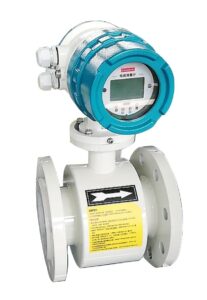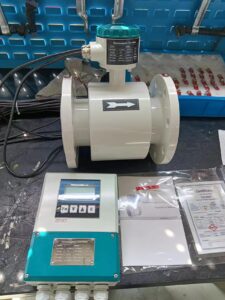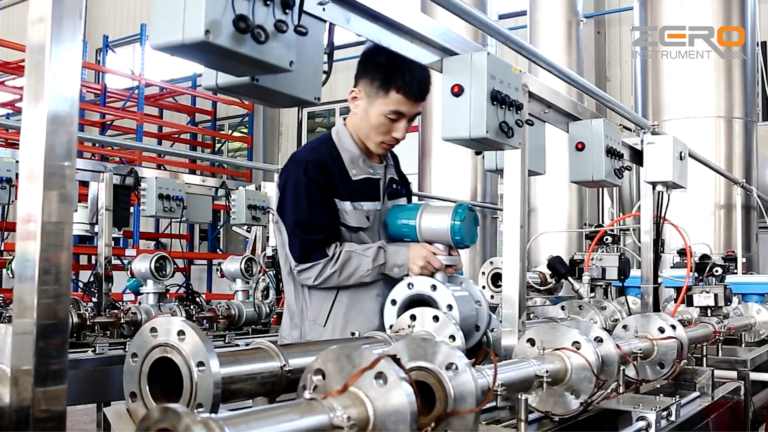An electromagnetic flowmeter is an inductive instrument that measures the volume flow of conductive media in a pipe based on Faraday’s law of electromagnetic induction.
The excitation coil in the pipe generates a magnetic field, and the measured medium flows through the pipe to cut magnetic lines of force, generating induced electromotive force on the two detection electrodes. , its size is proportional to the velocity of the fluid.
The measuring pipeline is electromagnetic isolated from the fluid and measuring electrode through a non-conductive lining (rubber, PTFE, PO, etc.).
After the voltage signal is converted to a converter and then processed by a microprocessor, it outputs a signal that is linearly related to the flow rate, which can be used by subsequent instruments for recording, adjustment and control. It can also communicate with the host computer through RS485.

1. Characteristics
The electromagnetic flowmeter has no moving parts and parts protruding from the fluid. It has high reliability and is used to measure various acids, alkalis, salt solutions, slurries, syrups, sewage, beer, wort, and other conductive fluids. Flow rate of various suspended solids, vaporized vapor and viscous substances. In addition, due to its good sealing performance, it can also be used in tap water and underground sewer systems.
2. Application
Electromagnetic flowmeters are now widely used in industrial technology and management departments such as electric power, chemical industry, environmental protection, metallurgy, medicine, papermaking, food, water supply and drainage, etc., to measure various acid, alkali, salt solutions, pulp, syrup, sewage, etc. For the flow rate of conductive fluid, the sanitary electromagnetic flowmeter is made of all stainless steel and can be used to measure the flow rate of beer, wort, medical water, etc.

3. Measurement accuracy
The electromagnetic flowmeter is not affected by changes in fluid density, viscosity, temperature, pressure and conductivity. The sensor-induced voltage signal has a linear relationship with the average flow rate, so the measurement accuracy is high, generally 0.5%.
Since this kind of sensor must maintain a certain proportional relationship between the resistance in the pipeline and the impedance of the measuring circuit, manufacturing difficulties begin when the conductivity of the measured medium is about 10 ohms·cm, and the principle arises when the conductivity is lower. It is difficult to operate, and the thermal noise level increases significantly with the increase of internal resistance.
4. Advantages of electromagnetic flowmeter
There are no flow obstructions in the measuring pipe, so there is no additional pressure loss; there are no moving parts in the measuring pipe, so the sensor has an extremely long life. Only the lining and electrodes of the sensor part are in contact with the liquid being measured. As long as the electrode and lining materials are properly selected, they can resist corrosion and wear. Anti-corrosion electromagnetic flowmeters can use special materials to make electrodes and linings, and can measure almost all corrosive media.

5. Installation environment requirements
1. The sensor should be installed in a dry and ventilated place, avoid places that are humid and prone to water accumulation, and should also try to avoid direct sunlight and direct rainwater.
2. Avoid installing in places where the ambient temperature is too high. The electromagnetic flowmeter with an integrated structure is also subject to the ambient temperature of the electronic components, which is lower.
3. There should be no strong leakage current on the pipeline where the sensor is installed, and it should be as far away as possible from equipment with strong electromagnetic fields, such as large electromechanical equipment, large transformers, etc., to avoid causing electromagnetic field interference;
4. The pipe or ground where the sensor is installed should not have strong vibrations, especially for integrated instruments;
5. The ambient temperature of the converter installation is between -10 and 45°C; the relative humidity of the air is ≤85%; there is no strong vibration at the installation site; the surrounding air does not contain corrosive gases; the converter should be installed indoors as much as possible. When installed outdoors, measures should also be taken to protect it from sunlight and rain.

6. Electromagnetic flowmeter selection
The selection of instruments is a very important task in instrument application. According to relevant data, 2/3 of the faults of instruments in practical applications are caused by incorrect selection and installation of instruments. Special attention should be paid to:
1. Name of the fluid being measured (to determine corrosiveness);
2. Maximum flow rate and minimum flow rate (determine the flow rate range);
3. Maximum working pressure;
4. Maximum temperature, minimum temperature;
5. The fluid to be measured must have certain conductivity, with conductivity ≥5uS/cm.
